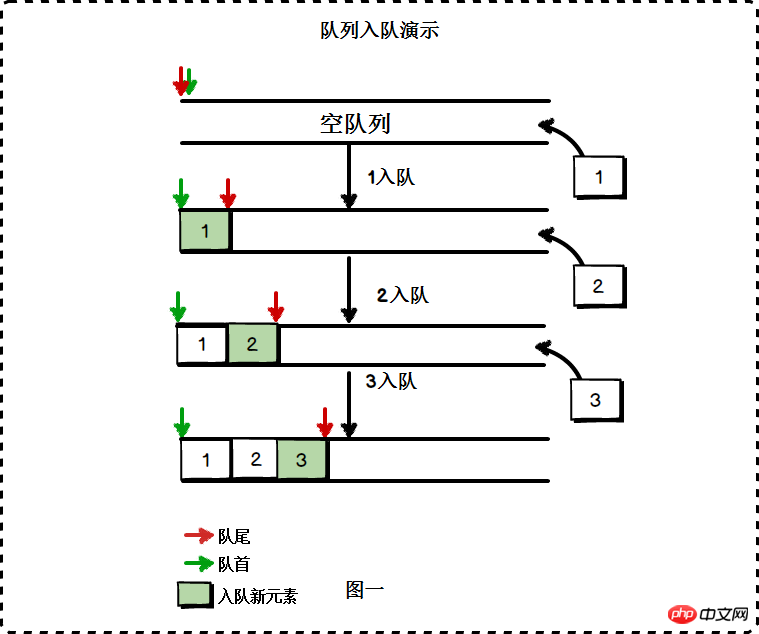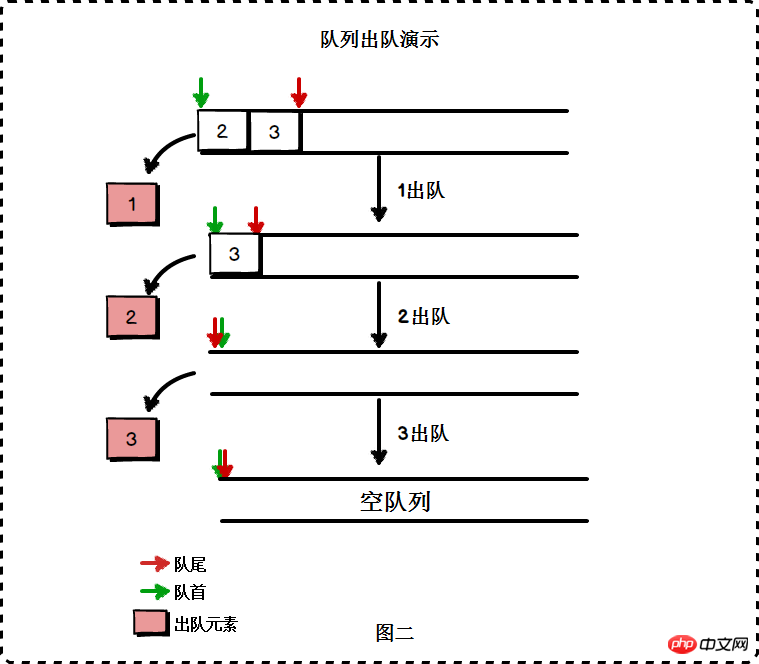 Backend Development
Backend Development
 PHP Tutorial
PHP Tutorial
 Detailed explanation of the queue principle in PHP and the graphic code for writing files
Detailed explanation of the queue principle in PHP and the graphic code for writing files
Detailed explanation of the queue principle in PHP and the graphic code for writing files
The examples in this article describe the PHP queue principle and queue-based file writing cases. Share it with everyone for your reference, the details are as follows:
The queue is a linear table, based on the first in first out principle:
Joining the team:

Leaving the team:

# #PHP implementation queue: The first element is the head of the queue, and the last element is the tail of the queue
<?php /** * 队列就是这么简单 * * @link */ $array = array('PHP', 'JAVA'); array_push($array, 'PYTHON'); //入队列 array_shift($array); //出队列
What is a double-ended queue (or two-way queue) Deque, the full name is double -ended queue?
That is, elements can be entered or dequeued at any part of the queue. If we call these methods insertLeft() and insertRight(), as well as removeLeft() and removeRight(). If calling the insertLeft() and removeLeft() methods is strictly prohibited (or the operation of the right segment is disabled), the double-ended queue functions like a stack. It is forbidden to call insertLeft() and removeRight() (or another pair of methods on the contrary), and its function is the same as a queue. A deque is a versatile data structure compared to a stack or queue.PHP implements double-ended queue
<?php
class Deque
{
public $queue = array();
/**(尾部)入队 **/
public function addLast($value)
{
return array_push($this->queue,$value);
}
/**(尾部)出队**/
public function removeLast()
{
return array_pop($this->queue);
}
/**(头部)入队**/
public function addFirst($value)
{
return array_unshift($this->queue,$value);
}
/**(头部)出队**/
public function removeFirst()
{
return array_shift($this->queue);
}
/**清空队列**/
public function makeEmpty()
{
unset($this->queue);
}
/**获取列头**/
public function getFirst()
{
return reset($this->queue);
}
/** 获取列尾 **/
public function getLast()
{
return end($this->queue);
}
/** 获取长度 **/
public function getLength()
{
return count($this->queue);
}
}Purpose of queue:
Queue can be very good Process data transmission and storage asynchronously. When you frequently insert data into the database and submit data to search engines, you can use queues to insert data asynchronously. In addition, slower processing logic and processing logic with limited concurrency can also be placed in the background for processing through message queues, such as FLV video conversion, sending mobile phone text messages, sending emails, etc. Project CaseThere is a project here. Due to server permission issues, there is no way to install the queue program, and there are more than 300 concurrent users. The service provider The maximum number of connections to the database is 300. In order to solve this problem, a simple queue program was written. The code is as follows
Read queue code:<?php
set_time_limit(0);
$file_name3 = '3.txt';//这个地方是讲队列文件读出的内容写入文件,test中代替的是mysql数据库操作
$file3 = fopen($file_name3,'a');
while(true)
{
$c = FALSE;
$file_name = '1.txt';//队列文件
$file = fopen($file_name,'r');
if(!feof($f))
{
//获得第一条数据
$a = fgets($file);
if(!empty($a))
{
$c = TRUE;
fwrite($file3,$a);//这里可以改为数据库操作
}
}
fclose($file);
if($c)
{
//将文件的第一条数据删除
exec('sed -i \'1d\' /var/www/csv_sql/1.txt');
}
sleep(1);
if(time()>=strtotime('20160416150000'))
{
exit;
}
}
fclose($file3);Reading the file
Writing the queue program is relatively simple, just write the file
<?php
set_time_limit(0);
$file_name2 = '2.txt';//test中用来比对队列程序是否正常的
$file2 = fopen($file_name2,'a');
for($i=1;$i<11;$i++)
{
$file_name = '1.txt';//队列文件
$file = fopen($file_name,'a');//fopen的mode属性必须是a或a+
$str = $i.'--'.rand(100001,999999);
fwrite($file,$str."\n");
fwrite($file2,$str."\n");
sleep(1);
fclose($file);
}
fclose($file2);The above is the detailed content of Detailed explanation of the queue principle in PHP and the graphic code for writing files. For more information, please follow other related articles on the PHP Chinese website!

Hot AI Tools

Undresser.AI Undress
AI-powered app for creating realistic nude photos

AI Clothes Remover
Online AI tool for removing clothes from photos.

Undress AI Tool
Undress images for free

Clothoff.io
AI clothes remover

AI Hentai Generator
Generate AI Hentai for free.

Hot Article

Hot Tools

Notepad++7.3.1
Easy-to-use and free code editor

SublimeText3 Chinese version
Chinese version, very easy to use

Zend Studio 13.0.1
Powerful PHP integrated development environment

Dreamweaver CS6
Visual web development tools

SublimeText3 Mac version
God-level code editing software (SublimeText3)

Hot Topics
 1378
1378
 52
52
 PHP 8.4 Installation and Upgrade guide for Ubuntu and Debian
Dec 24, 2024 pm 04:42 PM
PHP 8.4 Installation and Upgrade guide for Ubuntu and Debian
Dec 24, 2024 pm 04:42 PM
PHP 8.4 brings several new features, security improvements, and performance improvements with healthy amounts of feature deprecations and removals. This guide explains how to install PHP 8.4 or upgrade to PHP 8.4 on Ubuntu, Debian, or their derivati
 How To Set Up Visual Studio Code (VS Code) for PHP Development
Dec 20, 2024 am 11:31 AM
How To Set Up Visual Studio Code (VS Code) for PHP Development
Dec 20, 2024 am 11:31 AM
Visual Studio Code, also known as VS Code, is a free source code editor — or integrated development environment (IDE) — available for all major operating systems. With a large collection of extensions for many programming languages, VS Code can be c
 7 PHP Functions I Regret I Didn't Know Before
Nov 13, 2024 am 09:42 AM
7 PHP Functions I Regret I Didn't Know Before
Nov 13, 2024 am 09:42 AM
If you are an experienced PHP developer, you might have the feeling that you’ve been there and done that already.You have developed a significant number of applications, debugged millions of lines of code, and tweaked a bunch of scripts to achieve op
 How do you parse and process HTML/XML in PHP?
Feb 07, 2025 am 11:57 AM
How do you parse and process HTML/XML in PHP?
Feb 07, 2025 am 11:57 AM
This tutorial demonstrates how to efficiently process XML documents using PHP. XML (eXtensible Markup Language) is a versatile text-based markup language designed for both human readability and machine parsing. It's commonly used for data storage an
 Explain JSON Web Tokens (JWT) and their use case in PHP APIs.
Apr 05, 2025 am 12:04 AM
Explain JSON Web Tokens (JWT) and their use case in PHP APIs.
Apr 05, 2025 am 12:04 AM
JWT is an open standard based on JSON, used to securely transmit information between parties, mainly for identity authentication and information exchange. 1. JWT consists of three parts: Header, Payload and Signature. 2. The working principle of JWT includes three steps: generating JWT, verifying JWT and parsing Payload. 3. When using JWT for authentication in PHP, JWT can be generated and verified, and user role and permission information can be included in advanced usage. 4. Common errors include signature verification failure, token expiration, and payload oversized. Debugging skills include using debugging tools and logging. 5. Performance optimization and best practices include using appropriate signature algorithms, setting validity periods reasonably,
 PHP Program to Count Vowels in a String
Feb 07, 2025 pm 12:12 PM
PHP Program to Count Vowels in a String
Feb 07, 2025 pm 12:12 PM
A string is a sequence of characters, including letters, numbers, and symbols. This tutorial will learn how to calculate the number of vowels in a given string in PHP using different methods. The vowels in English are a, e, i, o, u, and they can be uppercase or lowercase. What is a vowel? Vowels are alphabetic characters that represent a specific pronunciation. There are five vowels in English, including uppercase and lowercase: a, e, i, o, u Example 1 Input: String = "Tutorialspoint" Output: 6 explain The vowels in the string "Tutorialspoint" are u, o, i, a, o, i. There are 6 yuan in total
 Explain late static binding in PHP (static::).
Apr 03, 2025 am 12:04 AM
Explain late static binding in PHP (static::).
Apr 03, 2025 am 12:04 AM
Static binding (static::) implements late static binding (LSB) in PHP, allowing calling classes to be referenced in static contexts rather than defining classes. 1) The parsing process is performed at runtime, 2) Look up the call class in the inheritance relationship, 3) It may bring performance overhead.
 What are PHP magic methods (__construct, __destruct, __call, __get, __set, etc.) and provide use cases?
Apr 03, 2025 am 12:03 AM
What are PHP magic methods (__construct, __destruct, __call, __get, __set, etc.) and provide use cases?
Apr 03, 2025 am 12:03 AM
What are the magic methods of PHP? PHP's magic methods include: 1.\_\_construct, used to initialize objects; 2.\_\_destruct, used to clean up resources; 3.\_\_call, handle non-existent method calls; 4.\_\_get, implement dynamic attribute access; 5.\_\_set, implement dynamic attribute settings. These methods are automatically called in certain situations, improving code flexibility and efficiency.



